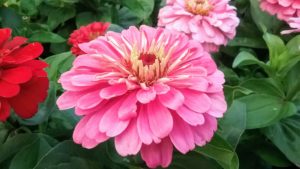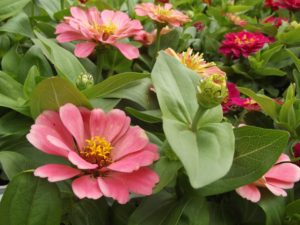 Zinnias make a brilliant addition to the summer flower garden, loved by novice and expert gardeners alike. The pollinators love them too! They bloom effortlessly from summer to frost, and the more you cut, the more they branch and bloom.
Zinnias make a brilliant addition to the summer flower garden, loved by novice and expert gardeners alike. The pollinators love them too! They bloom effortlessly from summer to frost, and the more you cut, the more they branch and bloom.
Zinnias are native to Mexico and as a frost-sensitive annual appreciate warm weather. They bloom heaviest when daylight is less than 12 hours.
GENERAL SOWING OR TRANSPLANTING

Sow or plant outside now. Zinnias love the warmer weather ahead. The ideal temperature for sowing zinnias and many warm-season annuals is about 70°+. Think of it as sunbathing weather. Or you can get a headstart planting zinnias from starter plants.
We have starts ready to go into the ground now as well as many varieties from seed.
Zinnias thrive in fertile, well-drained soil in full sun (6 hours or more). Improve the soil with Bumper Crop soil conditioner before transplanting. Sow a group of 3 seeds every 8″-12″ apart and ¼” deep, depending on the variety (consult your seed packet). Or plant 4″ or 6-pack starters.
Weeding
Keep zinnias well weeded, so they aren’t competing for water or nutrients. A well-weeded patch of zinnias also has more airflow, which helps avoid fungal disease. Cultivate shallowly, as zinnia roots are close to the soil surface.
Fertilization
Plan on fertilizing with E.B. Stone Organics Rose & Flower Food – It’s slow release, organic and promotes blooms.
Water
Keep zinnias consistently moist but not soggy; allowing the top inch of soil to dry between watering once plants are established. Water the soil, avoiding the foliage to help prevent fungal disease. Mulching zinnias can help to keep down weeds, avoid soil splashing that can spread disease, and also keep the soil more consistently moist.
Special Care
Once they have four sets of leaves, clip or pinch zinnia seedlings back to just above a set of leaves, to encourage them to branch out. Deadheading frequently keeps zinnias blooming because it stops them from producing seeds, encouraging them to begin the bloom cycle again.
HARVESTING
For extended vase life, harvest before the small yellow flowers emerge from between petals.
COMMON PESTS AND DISEASES
Powdery Mildew looks like a white powder on leaves and thrives in humid weather with cool nights. Reduce chances of this disease by keeping leaves dry while watering only in the morning and during the day. Proper spacing of plants will provide good air circulation, too. Do not compost diseased plants; spores may over-winter and re-infect crops the following season.
Follow us in Social Media